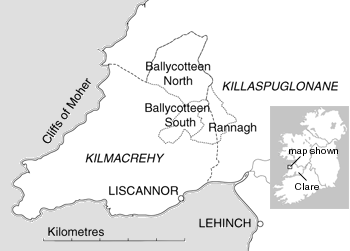The
Ballycotton
area
 Ballycotton (also spelt Ballycotteen)
(from the
Gaelic 'Baile' or 'Bally' place or farm, and 'cotton'
small
house) is a 'townland' a small farming area,
with no town, north of
Liscannor, in the parish or diocese of
Kilmacrehy, on the west coast of
County Clare.
Ballycotton (also spelt Ballycotteen)
(from the
Gaelic 'Baile' or 'Bally' place or farm, and 'cotton'
small
house) is a 'townland' a small farming area,
with no town, north of
Liscannor, in the parish or diocese of
Kilmacrehy, on the west coast of
County Clare.
Kilmacrehy, the parish which includes
Ballycotton and
Liscannor, derives from Cill McCreehy the church of
McCreehy
(in Liscannor). The neighbouring parish of Killaspuglnonane
derives
from the church of Bishop Flannan.
Clare is in the
province of Munster, on the west coast
of Ireland, between Galway bay to
the north and the Shannon river
in the south. Its major towns are Shannon,
Ennis and Corofin.
It takes its name from the Irish An Clár, a level
surface
or plain.
Liscannor, in Clare, takes its name from
Lios Ceannuir,
O'Connor's Fort, and started in the early 18th century. In
1703
it had an old castle out of repair, and three cabins. It claims
to
have the Pope as its Parish priest. John Holland, who invented
the
submarine, was born in Liscannor in 1841. East of Liscannor
are the remains
of St. Macreehy's Church (originally called Church
of McCreehy by the
seaside), a medieval parish church, built in
the early 12th century on the
site of a famous school founded
by St. Macreehy in the 6th century. Next to
the church ruin is
a cemetery, with many Greene
tombstones.
Lahinch (also called Lehinch) takes its name
from Leacht
Ui Chonchur O'Connor's Grave. It has an
'internationally
recognised golf course', and to its north, at O'Brien's
Bridge,
is Dough Castle, built by an O'Connor, and taken over by the
O'Briens.
On the cliffs of Moher ('the tallest cliffs in Europe'),
several
miles from Lahinch, is O'Brien's tower, built in 1835 as an
observation
point for strangers.
 Ballycotton (also spelt Ballycotteen)
(from the
Gaelic 'Baile' or 'Bally' place or farm, and 'cotton'
small
house) is a 'townland' a small farming area,
with no town, north of
Liscannor, in the parish or diocese of
Kilmacrehy, on the west coast of
County Clare.
Ballycotton (also spelt Ballycotteen)
(from the
Gaelic 'Baile' or 'Bally' place or farm, and 'cotton'
small
house) is a 'townland' a small farming area,
with no town, north of
Liscannor, in the parish or diocese of
Kilmacrehy, on the west coast of
County Clare.